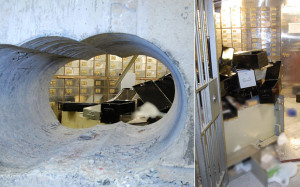
23 January 2016 -In 1992 there were 847 bank robberies in the UK; by 2011 that had dropped to just 66. Now Lawrence Dobbs writes in the Telegraph about how technology is killing off this age old profession. “The development of more sophisticated alarm systems and CCTV, as well as supporting forensic developments such as DNA analysis and facial recognition software, all serve to assist police,” says Jim Dickie, a former detective who spent more than 30 years with the Metropolitan Police. Those who do try are either feckless opportunists or “serial offenders” who have already served time and are easily found on police databases. “Hands-on heists are a dying art, because those who have a background in it are literally dying off.”
In 2015 a gang of aging jewel thieves pulled off one last spectacular job. Using a diamond-tipped drill and a 10-ton hydraulic ram, they broke into the Hatton Garden Safe Deposit Ltd vault and made off with at least £14million in precious stones, gems, bullion and jewelry in the largest burglary in English history.
But the Hatton Garden burglars were caught because they used one of their own cars within view of a security camera. According to David Kelly, it’s CCTV which has changed things most: “It’s now virtually impossible to travel through any public space in a major metropolitan area without being captured. They’re everywhere, the image quality is better, and the ability to store images for longer has increased.”
Then there are your physical alarm devices: motion sensors, window monitors which detect glass shattering, or devices which trigger when a door is opened. “These devices can now be deployed wirelessly – in an older building, where you might not have wires in place,” says Kelly. “There are also tools at the disposal of the private sector, in cooperation with the public sector, which are perhaps not matters of common knowledge, and there’s a tactical advantage to our clients in them remaining that way.”
Add to this the various technologies used to protect or track the loot itself – dye packs hiding inside stacks of banknotes, which explode when they leave a certain range; GPS tracking on security vans and inside cash containers – and you can see why even a hardened criminal might prefer to stay in bed.